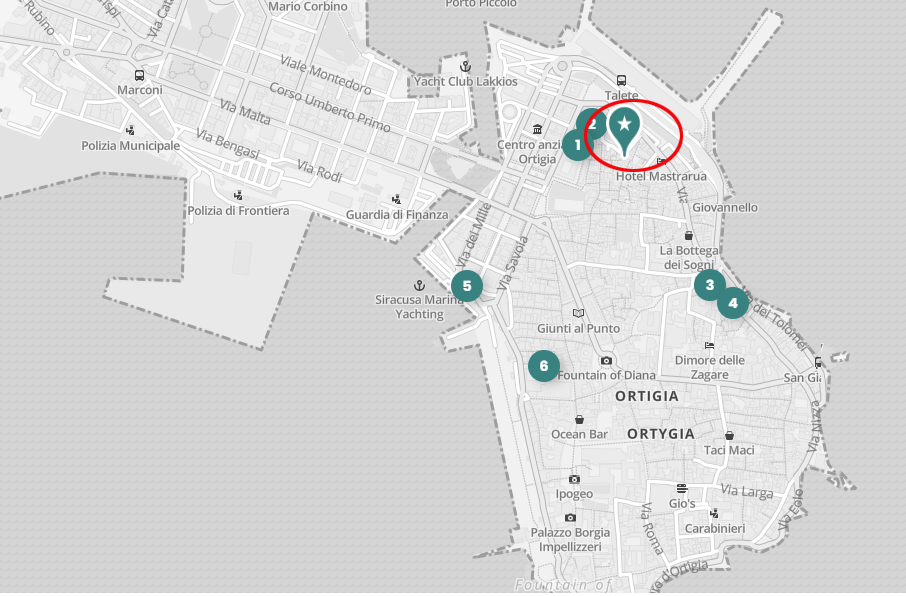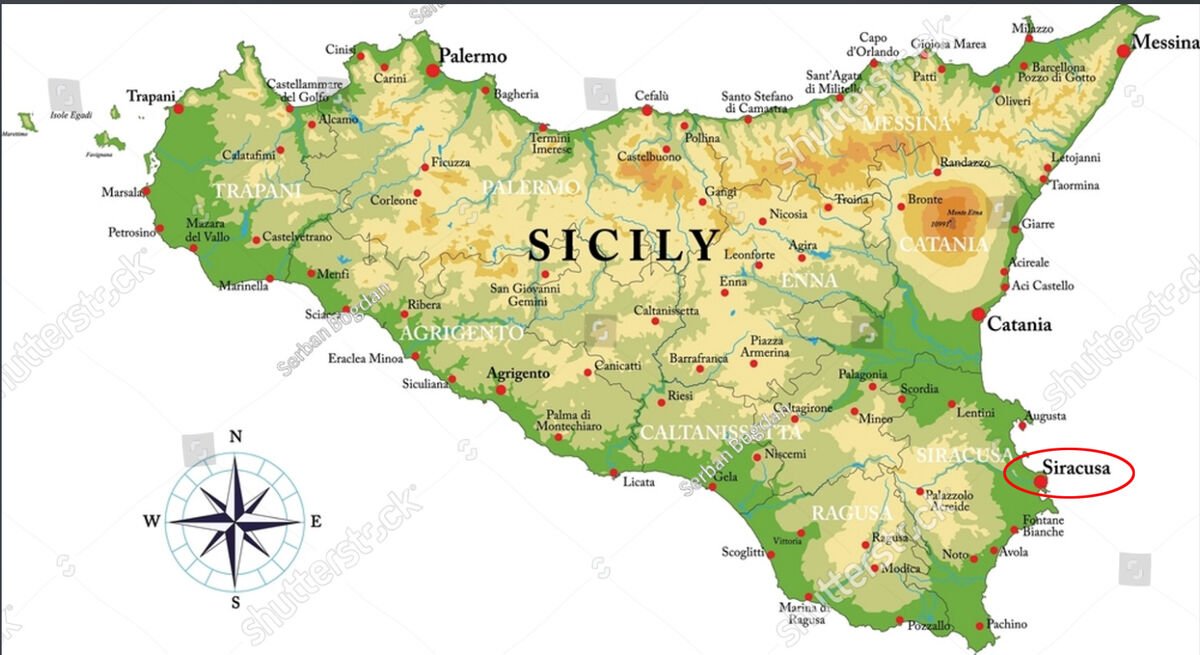Sicily: Siracusa Part 7 - The Balconies of Ortigia
Feb 28, 2024 14:01:25 #
Walking the streets of the old town in Ortigia, one is struck by the myriad of balconies on the buildings. Some are quite simple while others quite intricate with carved supports.
A little more about Ortigia from the website: https://travelnotesandbeyond.com/siracusa-sicily-ortigia-island-and-archeological-park/
One of the biggest attractions in Sicily is the town of Siracusa and its historic center – Ortigia Island (spelled both Ortygia and Ortigia). Of all the towns we visited in Sicily, I loved Siracusa the best. It’s one of the most fascinating places I have ever seen. “The biggest and most beautiful Greek city” – as Cicero described it.
This 2,700 year old Sicilian town still bears witness to the art and culture that have flourished in it throughout the centuries.
Unlike Palermo which is a complicated labyrinth of big streets and narrow alleys, Ortigia Island is relatively small and easy to visit. You can split your visit to Siracuse, Sicily, into two parts: one day for exploring Ortigia Island, and one day for visiting the Archaeological Park of Néapolis.
A Brief History of Siracusa and Ortigia Island
Siracusa (or Syracuse) was built on Ortigia Island which is located near the southeastern corner of Sicily. Ortigia was the site of an ancient Greek settlement founded by the Corinthians in 734 B.C.
In its greatest period of economic prosperity and military power, Siracusa had a population of 300,000. The city was home to many ancient Greek personalities, including Archimedes – the most famous mathematician and inventor of all times.
Throughout its history, Siracusa fell to the Romans, the Vandals, the Goths, the Arabs, the Normans, and to the Byzantines. The city also played an important role in the spreading of Judaism and Christianity in the central Mediterranean and then through the Italian peninsula. Physical evidence of all these cultures are still visible today when looking at the city’s ancient structures and medieval treasures.
Visiting Ortigia Island– the Heart of Siracusa, Sicily
Also known as Città Vecchia, the small island of Ortigia (or Ortygia, in English) is the oldest part of the beautiful city of Siracusa, Sicily. The name “Ortigia” derives from the Ancient Greek ortyx, which means “quail.” The best way to see Ortigia is just to wander around.
The island is fairly small (about 1km long and 600 meters wide), so you can’t loose your way here. To reach Ortigia you have to cross one of the three bridges that connect it to the mainland.
The old town of Ortigia is a labyrinth of charming ancient and medieval streets packed with over 2,500 years of history. It’s a paradise of sightseeing, dining and shopping, but also a great place to discover the history of Sicily.
A little About Balconies From: https://en.wikipedia.org/wiki/Balcony
A balcony (from Italian: balcone, "scaffold"[a]) is a platform projecting from the wall of a building, supported by columns or console brackets, and enclosed with a balustrade, usually above the ground floor. They are commonly found on multi-level houses, apartments and cruise ships.
Types
The traditional Maltese balcony is a wooden, closed balcony projecting from a wall.
In contrast, a Juliet balcony does not protrude out of the building. It is usually part of an upper floor, with a balustrade only at the front, resembling a small loggia. A modern Juliet balcony often involves a metal barrier placed in front of a high window that can be opened. In the UK, the technical name for one of these was officially changed in August 2020 to a Juliet guarding.
Juliet balconies are named after William Shakespeare's Juliet who, in traditional staging of the play Romeo and Juliet, is courted by Romeo while she is on her balcony—although the play itself, as written, makes no mention of a balcony, but only of a window at which Juliet appears. Various types of balcony have been used in depicting this famous scene; however the 'balcony of Juliet' at Villa Capuleti in Verona is not a 'Juliet balcony', as it does indeed protrude from the wall of the villa.Functions
A unit with a regular balcony will have doors that open onto a small patio with railings, a small patio garden or skyrise greenery. A French balcony is a false balcony, with doors that open to a railing with a view of the courtyard or the surrounding scenery below.
Sometimes balconies are adapted for ceremonial purposes, e.g. that of St. Peter's Basilica at Rome, when the newly elected pope gives his blessing urbi et orbi after the conclave. Inside churches, balconies are sometimes provided for the singers, and in banqueting halls and the like for the musicians.
In theatres, the balcony was formerly a stage-box, but the name is now usually confined to the part of the auditorium above the dress circle and below the gallery.
Balconies are part of the sculptural shape of the building allowing for irregular facades without the cost of irregular internal structures.
In addition to functioning as an outdoor space for a dwelling unit, balconies can also play a secondary role in building sustainability and indoor environmental quality (IEQ). Balconies have been shown to provide an overhang effect that helps prevent interior overheating by reducing solar gain, and may also have benefits in terms of blocking noise and improving natural ventilation within units.
Notable balconies
One of the most famous uses of a balcony is in traditional staging of the scene that has come to be known as the "balcony scene" in Shakespeare's tragedy Romeo and Juliet (though the scene makes no mention of a balcony, only of a window at which Juliet appears).
For additional images of the Archeological Park, the market and the Temple of Apollo please see my previous posts:
https://www.uglyhedgehog.com/t-799740-1.html
https://www.uglyhedgehog.com/t-799893-1.html
https://www.uglyhedgehog.com/t-800136-1.html
https://www.uglyhedgehog.com/t-800275-1.html
https://www.uglyhedgehog.com/t-800444-1.html
https://www.uglyhedgehog.com/t-800697-1.html
I hope you enjoy these!
Mark
A little more about Ortigia from the website: https://travelnotesandbeyond.com/siracusa-sicily-ortigia-island-and-archeological-park/
One of the biggest attractions in Sicily is the town of Siracusa and its historic center – Ortigia Island (spelled both Ortygia and Ortigia). Of all the towns we visited in Sicily, I loved Siracusa the best. It’s one of the most fascinating places I have ever seen. “The biggest and most beautiful Greek city” – as Cicero described it.
This 2,700 year old Sicilian town still bears witness to the art and culture that have flourished in it throughout the centuries.
Unlike Palermo which is a complicated labyrinth of big streets and narrow alleys, Ortigia Island is relatively small and easy to visit. You can split your visit to Siracuse, Sicily, into two parts: one day for exploring Ortigia Island, and one day for visiting the Archaeological Park of Néapolis.
A Brief History of Siracusa and Ortigia Island
Siracusa (or Syracuse) was built on Ortigia Island which is located near the southeastern corner of Sicily. Ortigia was the site of an ancient Greek settlement founded by the Corinthians in 734 B.C.
In its greatest period of economic prosperity and military power, Siracusa had a population of 300,000. The city was home to many ancient Greek personalities, including Archimedes – the most famous mathematician and inventor of all times.
Throughout its history, Siracusa fell to the Romans, the Vandals, the Goths, the Arabs, the Normans, and to the Byzantines. The city also played an important role in the spreading of Judaism and Christianity in the central Mediterranean and then through the Italian peninsula. Physical evidence of all these cultures are still visible today when looking at the city’s ancient structures and medieval treasures.
Visiting Ortigia Island– the Heart of Siracusa, Sicily
Also known as Città Vecchia, the small island of Ortigia (or Ortygia, in English) is the oldest part of the beautiful city of Siracusa, Sicily. The name “Ortigia” derives from the Ancient Greek ortyx, which means “quail.” The best way to see Ortigia is just to wander around.
The island is fairly small (about 1km long and 600 meters wide), so you can’t loose your way here. To reach Ortigia you have to cross one of the three bridges that connect it to the mainland.
The old town of Ortigia is a labyrinth of charming ancient and medieval streets packed with over 2,500 years of history. It’s a paradise of sightseeing, dining and shopping, but also a great place to discover the history of Sicily.
A little About Balconies From: https://en.wikipedia.org/wiki/Balcony
A balcony (from Italian: balcone, "scaffold"[a]) is a platform projecting from the wall of a building, supported by columns or console brackets, and enclosed with a balustrade, usually above the ground floor. They are commonly found on multi-level houses, apartments and cruise ships.
Types
The traditional Maltese balcony is a wooden, closed balcony projecting from a wall.
In contrast, a Juliet balcony does not protrude out of the building. It is usually part of an upper floor, with a balustrade only at the front, resembling a small loggia. A modern Juliet balcony often involves a metal barrier placed in front of a high window that can be opened. In the UK, the technical name for one of these was officially changed in August 2020 to a Juliet guarding.
Juliet balconies are named after William Shakespeare's Juliet who, in traditional staging of the play Romeo and Juliet, is courted by Romeo while she is on her balcony—although the play itself, as written, makes no mention of a balcony, but only of a window at which Juliet appears. Various types of balcony have been used in depicting this famous scene; however the 'balcony of Juliet' at Villa Capuleti in Verona is not a 'Juliet balcony', as it does indeed protrude from the wall of the villa.Functions
A unit with a regular balcony will have doors that open onto a small patio with railings, a small patio garden or skyrise greenery. A French balcony is a false balcony, with doors that open to a railing with a view of the courtyard or the surrounding scenery below.
Sometimes balconies are adapted for ceremonial purposes, e.g. that of St. Peter's Basilica at Rome, when the newly elected pope gives his blessing urbi et orbi after the conclave. Inside churches, balconies are sometimes provided for the singers, and in banqueting halls and the like for the musicians.
In theatres, the balcony was formerly a stage-box, but the name is now usually confined to the part of the auditorium above the dress circle and below the gallery.
Balconies are part of the sculptural shape of the building allowing for irregular facades without the cost of irregular internal structures.
In addition to functioning as an outdoor space for a dwelling unit, balconies can also play a secondary role in building sustainability and indoor environmental quality (IEQ). Balconies have been shown to provide an overhang effect that helps prevent interior overheating by reducing solar gain, and may also have benefits in terms of blocking noise and improving natural ventilation within units.
Notable balconies
One of the most famous uses of a balcony is in traditional staging of the scene that has come to be known as the "balcony scene" in Shakespeare's tragedy Romeo and Juliet (though the scene makes no mention of a balcony, only of a window at which Juliet appears).
For additional images of the Archeological Park, the market and the Temple of Apollo please see my previous posts:
https://www.uglyhedgehog.com/t-799740-1.html
https://www.uglyhedgehog.com/t-799893-1.html
https://www.uglyhedgehog.com/t-800136-1.html
https://www.uglyhedgehog.com/t-800275-1.html
https://www.uglyhedgehog.com/t-800444-1.html
https://www.uglyhedgehog.com/t-800697-1.html
I hope you enjoy these!
Mark
I was not looking up at the balconies when I took this picture!
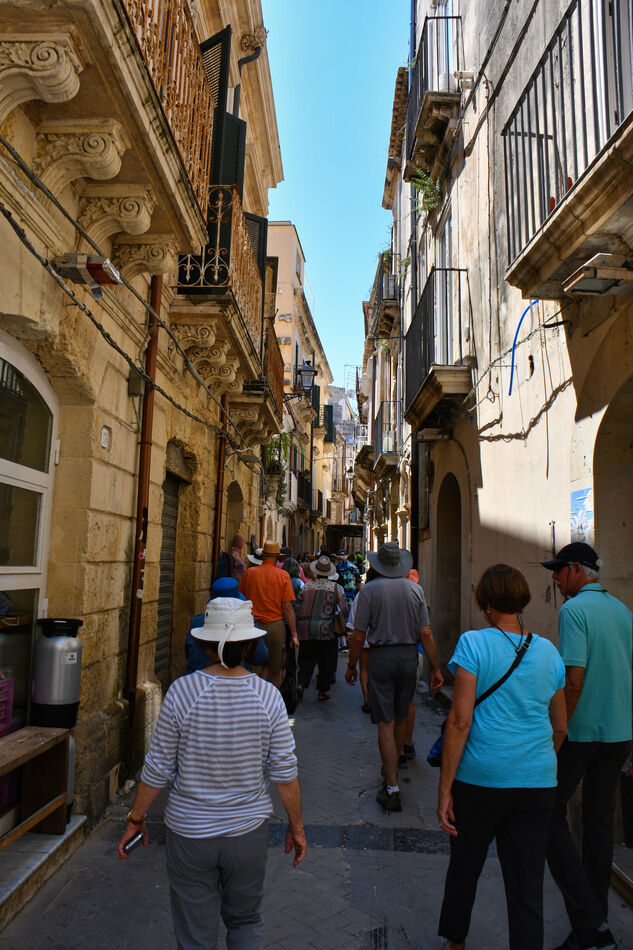
(Download)
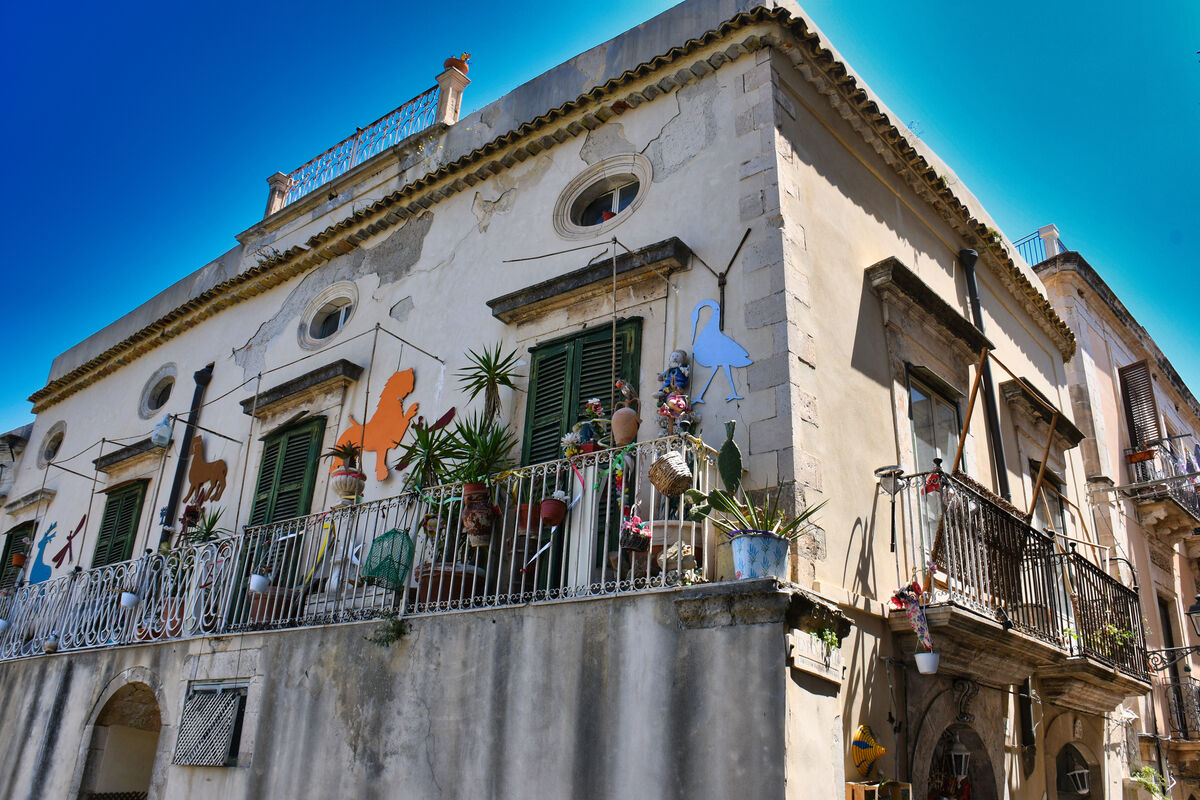
(Download)
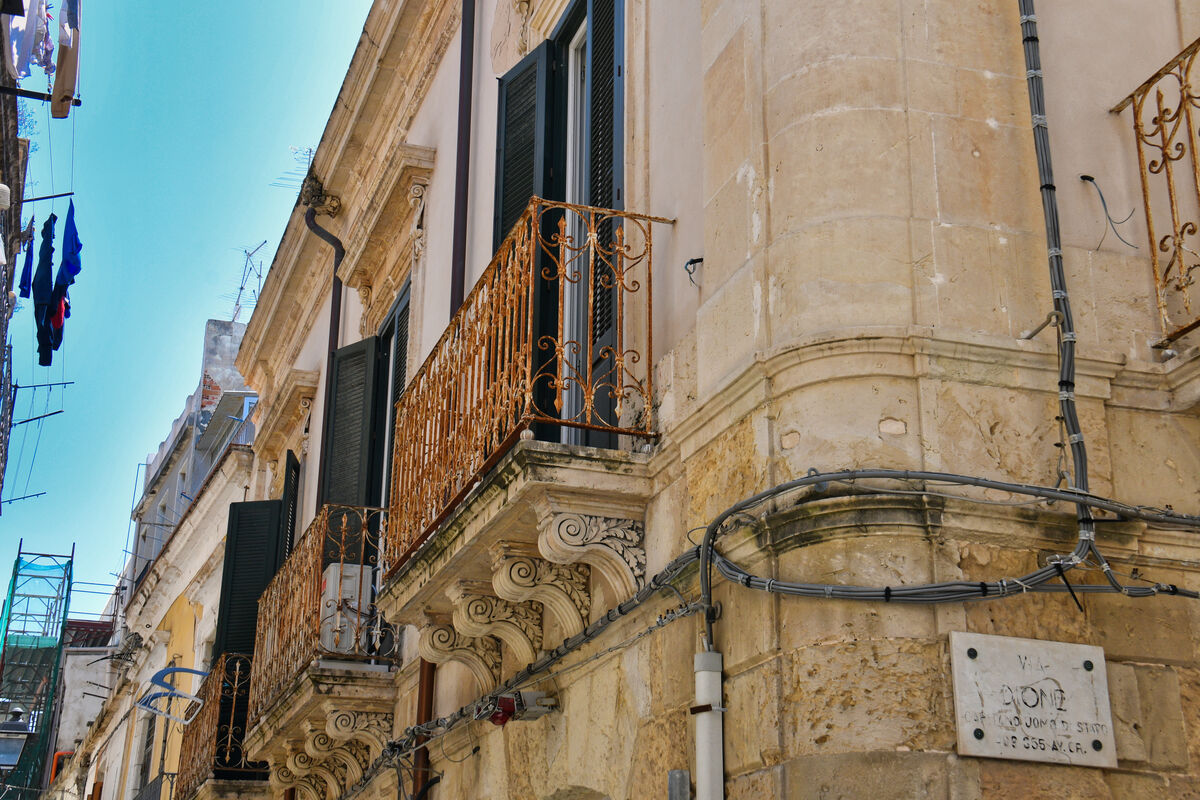
(Download)
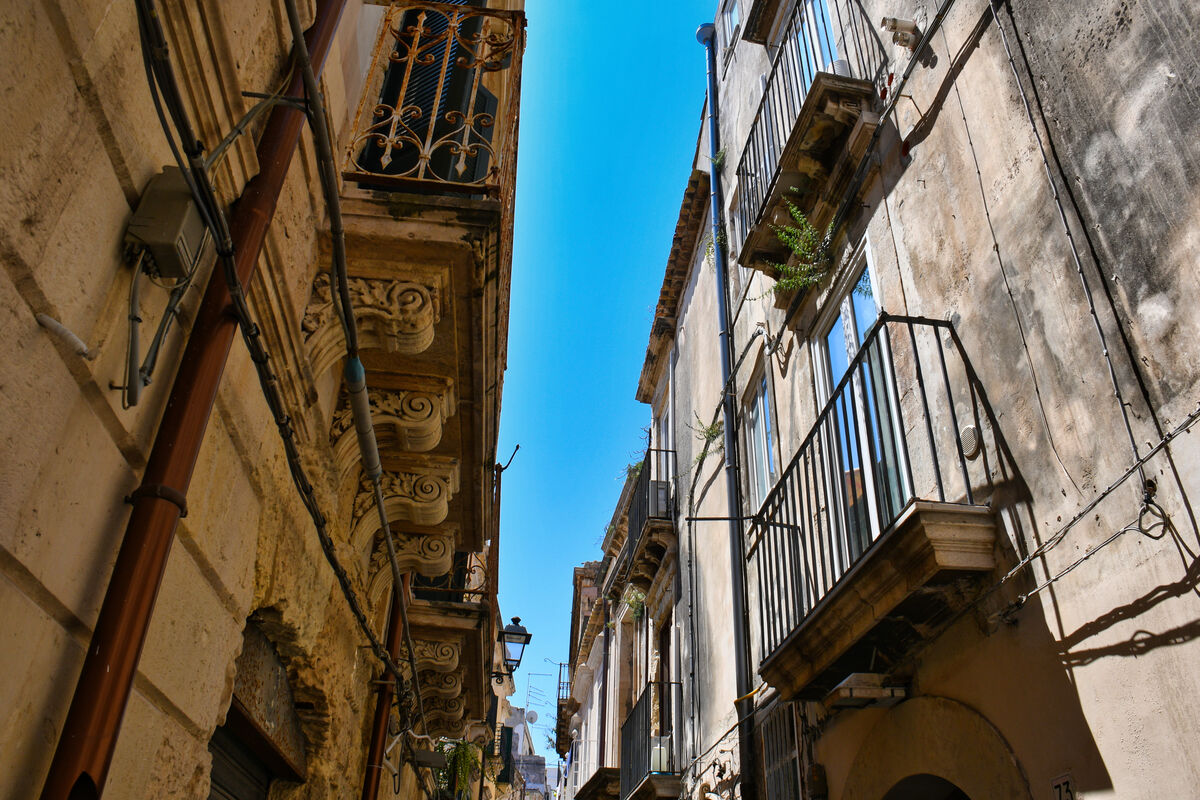
(Download)

(Download)

(Download)

(Download)

(Download)

(Download)
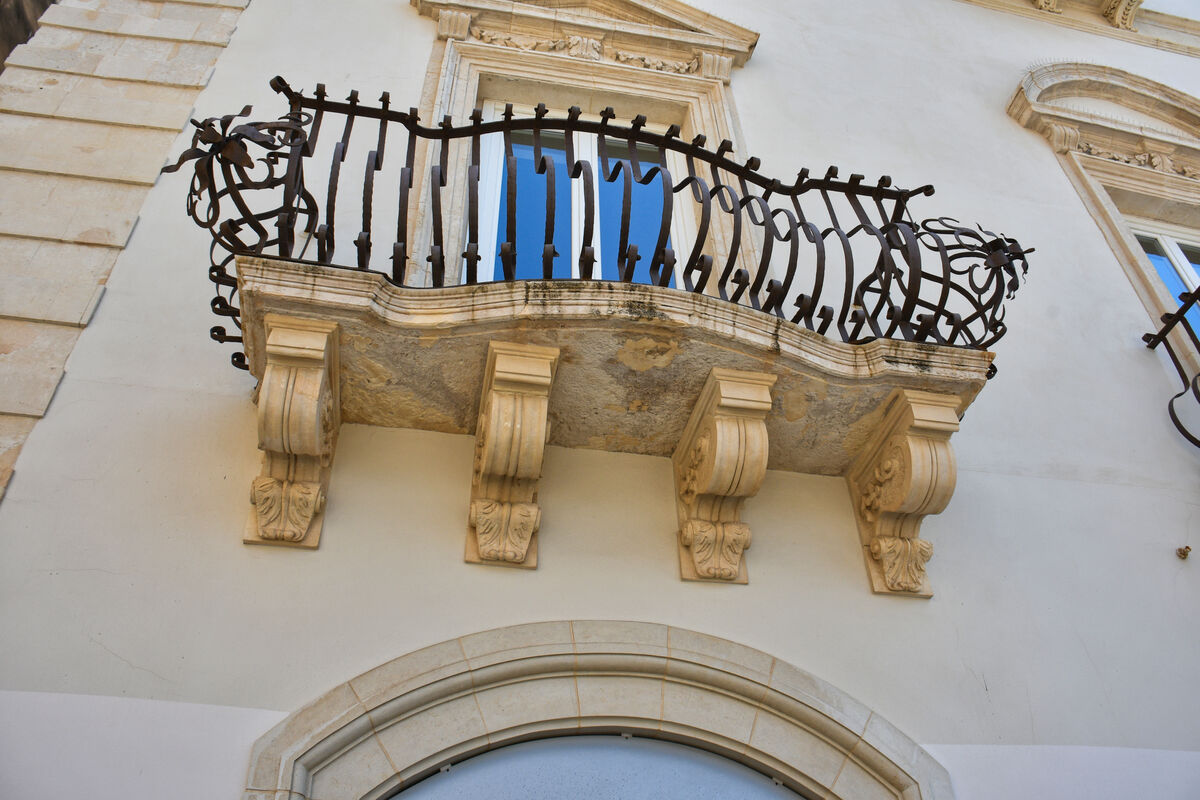
(Download)
Feb 28, 2024 14:02:41 #
Feb 28, 2024 16:03:51 #
srfmhg wrote:
Walking the streets of the old town in Ortigia, on... (show quote)
Beautiful shots of the beguiling atmosphere (And I'm never going to worry about anything peeling off the side of my place) ⭐⭐🎈⭐⭐
Feb 28, 2024 17:17:57 #
Feb 28, 2024 18:06:23 #
Beautiful balcony set, Mark! I understand that it is hard to look away from Gail.
Feb 28, 2024 18:51:37 #
joecichjr wrote:
Beautiful shots of the beguiling atmosphere (And I'm never going to worry about anything peeling off the side of my place) ⭐⭐🎈⭐⭐
Thanks very much Joe.
Feb 28, 2024 18:54:12 #
NMGal wrote:
Think I would wear a hard hat on some of those walks.
Thanks Barbara. I don't know the incidence of injuries from falling objects from balconies but no "hardhat only area" signs.
Feb 28, 2024 18:55:55 #
UTMike wrote:
Beautiful balcony set, Mark! I understand that it is hard to look away from Gail.
Thanks very much Mike. I've enjoyed looking at her for 60 years!
Feb 29, 2024 01:03:25 #
srfmhg wrote:
Walking the streets of the old town in Ortigia, on... (show quote)
Great set Mark. I just love wandering around Italian cities like this.
Feb 29, 2024 06:16:48 #
Feb 29, 2024 06:51:55 #
Wonderful balcony series, Mark. Loved seeing the elaborate buttresses. Good idea looking where your walking; you didn’t want to bump into that beautiful woman. 😊
Feb 29, 2024 07:21:06 #
Feb 29, 2024 07:37:36 #
Feb 29, 2024 07:50:34 #
Feb 29, 2024 08:29:16 #
If you want to reply, then register here. Registration is free and your account is created instantly, so you can post right away.

